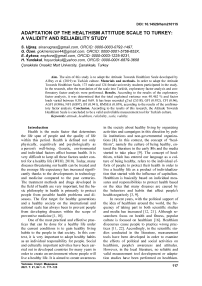Adaptation of the healthism attitude scale to turkey: a validity and reliability study
Автор: Ura S., Zen G., Aykora E., Yurdakul H.
Журнал: Человек. Спорт. Медицина @hsm-susu
Рубрика: Спортивная тренировка
Статья в выпуске: 1 т.21, 2021 года.
Бесплатный доступ
Aim. The aim of this study is to adapt the Attitude Towards Healthism Scale developed by Alfrey et al. (2019) to Turkish culture. Materials and methods. In order to adapt the Attitude Towards Healthism Scale, 173 male and 124 female university students participated in the study. In the research, after the translation of the scale into Turkish, exploratory factor analysis and confirmatory factor analysis were performed. Results. According to the results of the exploratory factor analysis, it was determined that the total explained variance was 40.462 % and factor loads varied between 0.38 and 0.69. It has been recorded χ2/sd (2.018), GFI (0.932), CFI (0.96), AGFI (0.906), NFI (0.897), IFI (0.941), RMSEA (0.059), according to the results of the confirmatory factor analysis. Conclusion. According to the results of this research, the Attitude Towards Healthism Scale is concluded to be a valid and reliable measurement tool for Turkish culture.
Attitude, healthism, reliability, scale, validity
Короткий адрес: https://sciup.org/147233661
IDR: 147233661 | DOI: 10.14529/hsm210115
Список литературы Adaptation of the healthism attitude scale to turkey: a validity and reliability study
- Ali A., Katz D.L. Disease Prevention and Health Promotion: How Integrative Medicine Fits. American Journal of Preventive Medicine, 2015, vol. 49, no. 5, pp. 230-240.
- Alpar R. Spor, Saglik ve Egitim Bilimle-rinden Orneklerle Uygulamali istatistik ve Gegerlik-Guvenirlik. Detay Yayincilik, 2014.
- Atilla G., Buyuker I§ler D.A. Qualitative Pre-Study on Healthism as a Consumer Object. Dumlupinar University Journal of Social Science, 2012, no. 34, pp. 221-230.
- Alfrey L., O'Connor J., Phillipson S. et al. Attitudes of Pre-Service Physical Education Teachers to Healthism: Development and Validation of the Attitude Towards Healthism Scale (ATHS). European Physical Education Review, 2019, vol. 25, no. 2, pp. 424-437. DOI: 10.1177/1356336X17742665
- Brown T.A. Confirmatory Factor Analysis for Applied Research. New Jersey: Guilford Publications, 2006
- Bryman A., Cramer D. Quantitative Data Analysis with SPSS Release 1o for Windows. London: Routledge, 2001. DOI: 10.4324/9780203459621
- Buyukozturk §. Veri Analizi El Kitabi. Ankara: Pegem Akademi, 2016.
- Clarke E.A. What is Preventive Medicine? Canadian Family Physician, 1974, vol. 20, no. 11, pp. 65-68.
- Crawford R. Healthism and the Medicali-zation of Everyday Life. International Journal of Health Services, 1980, vol. 10, no. 3, pp. 365-388. DOI: 10.2190/3H2H-3XJN-3KAY-G9NY
- Eggert R.W., Parkinson M.D. Preventive Medicine and Health System Reform: Improving Physician Education, Training, and Practice. JAMA, 1994, vol. 272, no. 9, pp. 688-693.
- Evans B. 'Be Fit Not Fat': Broadening the Childhood Obesity Debate Beyond Dualisms'. Children's Geographies, 2004, no. 2.2, pp.288-291.
- Greenhalgh T., Wessely S. Health for Me: a Sociocultural Analysis of Healthism in the Middle Classes. British Medical Bulletin, 2004, vol. 69, no. 1, pp. 197-213. DOI: 10.1093/bmb/ldh013
- Hooper D., Coughlan J., Mullen M. Structural Equation Modelling: Guidelines for Determining Model Fit. Electronic Journal of Business Research Methods, 2008, vol. 6, no. 1, pp.53-60.
- Jones M. Makeover Culture's Dark Side: Breasts, Death and Lolo Ferrari. Body & Society, 2008, no. 14, pp. 89-104. DOI: 10.1177/ 1357034X07087532
- Kline R.B. Principle and Practice of Structural Equation Modelling (4 ed.). New York: The Guilford Press, 2016.
- Lee J., Macdonald D. 'Are They Just Checking our Obesity or what?'The Healthism Discourse and Rural Young Women. Sport, Education and Society, 2010, no. 15.2, pp. 203-219. DOI: 10.1080/13573321003683851
- MacCallum R.C., Browne M.W., Suga-wara H.M. Power Analysis and Determination of Sample Size for Covariance Structure Modeling. Psychological Methods, 1996, vol. 1 (2), pp. 130-149. DOI: 10.1037/1082-989X.1.2.130
- Rysst M. "Healthism" and Looking Good: Body Ideals and Body Practices in Norway. Scandinavian Journal of Public Health, 2010, vol. 38 (5 suppl.), pp. 71-80.
- Wolf E.J., Harrington K.M., Clark S.L., Miller M.W. Sample Size Requirements for Structural Equation Models: An Evaluation of Power, Bias, and Solution Propriety. National Institutes of Health, 2013, vol. 76, no. 6, pp. 913-934. DOI: 10.1177/0013164413495237
- Stevens J.P. Applied Multivariate Statistics for The Social Sciences (Fourth Edition). New Jersey: Lawrance Erlbaum Association, 2002.
- Turrini M. A Genealogy of "Healthism". Ea - Journal of Medical Humanities & Social Studies of Science and Technology, 2015, vol. 7, no. 1, pp. 11-27.
- Wright J., Burrows L. "Being Healthy": the Discursive Construction of Health in New Zealand Children's Responses to the National Education Monitoring Project. Discourse: Studies in the Cultural Politics of Education, 2004, no. 25.2, pp. 211-230. DOI: 10.1080/ 01596300410001692157


